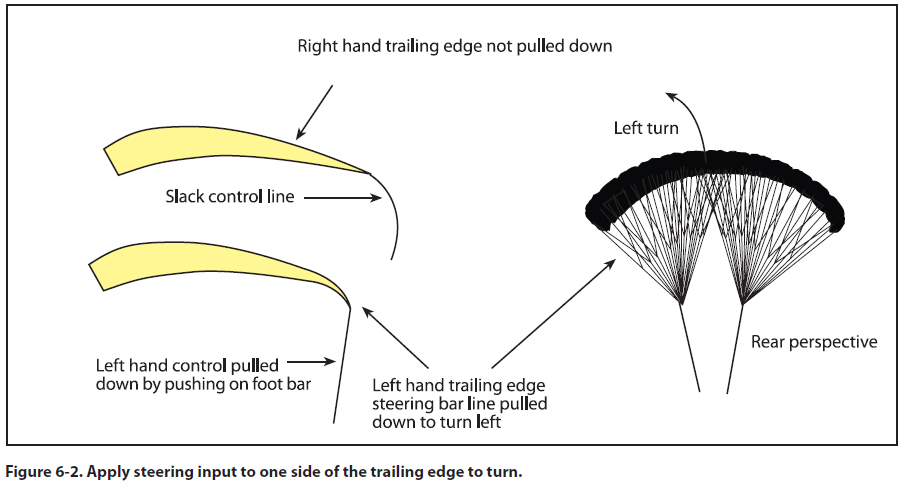|
Chapter 6 — Basic Flight Maneuvers
Clearing Turns
Pilots should perform clearing turns prior to beginning
any maneuver and any turns. Proper clearing
procedures combined with proper visual scanning
techniques are the most effective strategy for collision
avoidance. The essential idea of the clearing turn
is to be certain that the next maneuver is not going
to proceed into another aircraft’s flightpath. Refer to
Chapter 9.
Turning the Powered Parachute
Steering lines run from the foot controls, through a
series of pulleys parallel to the risers and suspension
lines and are connected to the trailing edge of the corresponding
side of the wing. The right steering line at
the front end is attached to the right steering control
at the cockpit (either foot or hand control), and the
other end is directly attached to the trailing edge of the
right side of the wing. Hence, when you push a foot
steering control, you pull on a steering line and “pulldown”
the trailing edge of the corresponding side of
the wing, which creates drag on that side of the wing’s
trailing edge. The drag from the pulled-down trailing
edge slows down and drops that side’s wing, and
the opposite side of the wing simultaneously pivots
around the vertical and longitudinal axes in a coordinated
turn. The PPC is designed to fly straight into
the relative wind, which is a key factor in the PPC’s
ability to automatically perform a coordinated turn.
[Figure 6-2]

While airborne, you will turn in the same direction
of the foot steering control that you push: push right
foot—go right; push left foot—go left.
Similar to the pendulum effect with throttle, there
can also be a swinging pendulum effect during turns.
For example, if you are in a stabilized right, mediumbanked
turn (approximately 20 to 45 degrees bank),
the pendulum is swinging out opposing the lift component
of the wing. If an abrupt left turn is initiated,
the wing will start to turn but the momentum of the
cart cannot respond as quickly. This results in the pilot
not coordinating the pendulum effect, and can be
avoided with smoother and less abrupt turns so the
cart can keep up with the wing.
Feel of the PPC
The ability to sense a flight condition, without relying
on cockpit instrumentation, is often called “feel of the
PPC,” but senses in addition to “feel” are involved.
Sounds inherent to flight are an important sense in
developing “feel.” The air rushes past the PPC pilot,
who is not typically masked by enclosures. When the
level of sound increases, it indicates that speed is increasing.
Also, the powerplant emits distinctive sound
patterns in different conditions of flight as the RPM
is adjusted. The sound of the engine in cruise flight
may be different from that in a climb, and different
again from that in a descent and can aid the pilot in
estimating not only the present airspeed but the airspeed
trend.
The sources of actual “feel” are important to the pilot.
The pilot’s own body responds to forces of acceleration.
These “G” loads imposed on the cart are also felt
by the pilot. Increased G loads force the pilot down into the seat or raise the pilot against the seat belt.
Radial accelerations produce side loadings, which
will shift the pilot from side to side in the seat. These
forces need not be strong, only perceptible by the pilot
to be useful.
An accomplished pilot who has excellent “feel” for
the PPC will be able to understand and coordinate the
rate of bank change so as not to overshoot the desired
course or bank, and ultimately be able to anticipate
the pendulum effect. The wing trailing edge control
surfaces move in the airstream and meet resistance
proportional to the speed and weight of the cart. When
the cart is heavy and flying faster, the steering controls
are stiffer and harder to move because the wing
internal pressure is higher. When the cart is light and
flying slower, there is less force required and controls
move easier.
The senses that contribute to “feel” of the airplane
are inherent in people. However, “feel” must be developed.
The flight instructor should direct the beginning
pilot to be attuned to these senses and teach an
awareness of their meaning as it relates to various
conditions of flight. To do this effectively, the flight
instructor must fully understand the difference between
perceiving something and merely noticing it. It
is a well established fact that the pilot who develops
a “feel” for the PPC early in flight training will have
little difficulty with advanced flight maneuvers.
|

